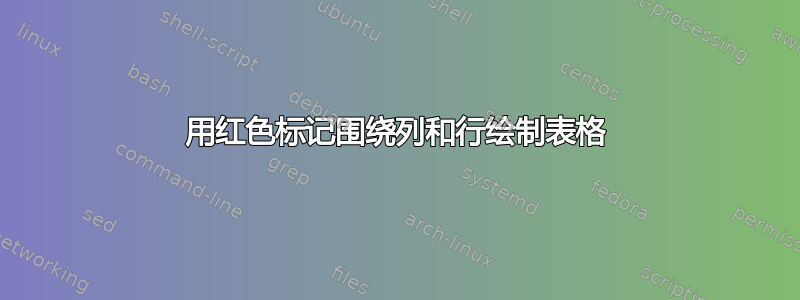
我使用了以下代码来绘制画面:
\begin{equation*}
\begin{array}{cc|cccccccc|c}
& & x_1 & x_2 & x_3 & s_1 & s_2 & s_3 & a_2 & a_3 & \\
\text{Basis} & c_B & 12 & 18 & 10 & 0 & 0 & 0 & -M & -M & \text{RHS} \\ \hline
s_1 & 0 & 2 & 3 & 4 & 1 & 0 & 0 & 0 & 0 & 50 \\
a_2 & -M & 1 & -1 & -1 & 0 & -1 & 0 & 1 & 0 & 0 \\
a_3 & -M & 0 & 1 & -1.5 & 0 & 0 &-1 & 0 & 1 & 0 \\ \hline
\multicolumn{2}{c|}{z_{j}} & -M & -0 & 2.5M & 0 & M & M & -M & -M & 0 \\
\multicolumn{2}{c|}{c_{j}-z_{j}} &12+M & 18 &10-2.5M& 0 & -M & 0 & 0 & 0 & \\
\end{array}
\end{equation*}
我认为我可以使用 \hline 和 \vline 命令,但我不知道如何使用!或者我只是将其绘制为图片 :)
答案1
\documentclass[fleqn]{article}
\usepackage{amsmath}
\usepackage{tikz}
\usetikzlibrary{tikzmark,fit}
\begin{document}
\begin{equation*}
\begin{array}{cc|cccccccc|c}
& & x_1 & x_2 & x_3 & s_1 & s_2 & s_3 & a_2 & a_3 & \\
\text{Basis} & c_B & 12 & 18 & 10 & 0 & 0 & 0 & -M & -M & \text{RHS} \\ \hline
s_1 & 0 & \tikzmarknode{2}{2} & 3 & 4 & 1 & 0 & 0 & 0 & 0 & 50 \\
a_2 & -M & \tikzmarknode{1}{1} & -1 & -1 & 0 & -1 & 0 & 1 & 0 & \tikzmarknode{0'}{0} \\
a_3 & -M & \tikzmarknode{0}{0} & 1 & -1.5 & 0 & 0 &-1 & 0 & 1 & 0 \\ \hline
\multicolumn{2}{c|}{z_{j}} & -M & -0 & 2.5M & 0 & M & M & -M & -M & 0 \\
\multicolumn{2}{c|}{c_{j}-z_{j}} &\tikzmarknode{pr}{12+M} & 18 &10-2.5M& 0 & -M & 0 & 0 & 0 & \\
\multicolumn{11}{c}{\vphantom{\uparrow}}
\end{array}
\begin{tikzpicture}[overlay,remember picture,red,semithick,
pfit/.style={draw,inner sep=2pt,rounded
corners=1pt,fit=#1}]
\node[pfit=(1)(0'),inner xsep=1em](pf1){};
\node[pfit=(2)(0),yshift=-1pt](pf2){};
\draw[stealth-] (pf1.east) -- ++ (1em,0);
\draw[stealth-] ([yshift=-2pt]pr.south) -- ++ (0,-1em);
\end{tikzpicture}
\end{equation*}
\end{document}
答案2
这是一种简单的方法pstricks:创建一些条目节点,并将它们连接起来\ncbox:
\documentclass{article}
\usepackage{array}
\usepackage{mathtools}
\usepackage{pst-node}
\begin{document}
\begin{equation*}
\renewcommand{\arraystretch}{1.2}
\begin{array}{cc|*{8}{c}|c}
& & x_1 & x_2 & x_3 & s_1 & s_2 & s_3 & a_2 & a_3 & \\
\text{Basis} & c_B & 12 & 18 & 10 & 0 & 0 & 0 & -M & -M & \text{RHS} \\ \hline
s_1 & 0 & \Rnode{C}{2} & 3 & 4 & 1 & 0 & 0 & 0 & 0 & 50 \\
a_2 & -M &\Rnode{A}{ 1 }& -1 & -1 & 0 & -1 & 0 & 1 & 0 &\Rnode{B}{0}\\
a_3 & -M & \Rnode{D}{0} & 1 & -1.5 & 0 & 0 &-1 & 0 & 1 & 0 \\ \hline
\multicolumn{2}{c|}{z_{j}} & -M & -0 & 2.5M & 0 & M & M & -M & -M & 0 \\
\multicolumn{2}{c|}{c_{j}-z_{j}} &12+M & 18 &10-2.5M& 0 & -M & 0 & 0 & 0 & \\
\end{array}
\psset{linewidth=1pt, linearc=0.1, linecolor=red, boxsize=0.7em}
\ncbox[nodesep=1.5em]{A}{B}\ncbox[nodesep=0.5ex]{C}{D}
\end{equation*}
\end{document}
答案3
{NiceTabular}这是使用和 TikZ 的解决方案,使用数组中nicematrix创建的 TikZ 节点来绘制元素。nicematrix
\documentclass{article}
\usepackage{nicematrix,tikz}
\begin{document}
\begin{equation*}
\begin{NiceArray}{cc|cccccccc|c}
& & x_1 & x_2 & x_3 & s_1 & s_2 & s_3 & a_2 & a_3 & \\
\text{Basis} & c_B & 12 & 18 & 10 & 0 & 0 & 0 & -M & -M & \text{RHS} \\ \hline
s_1 & 0 & 2 & 3 & 4 & 1 & 0 & 0 & 0 & 0 & 50 \\
a_2 & -M & 1 & -1 & -1 & 0 & -1 & 0 & 1 & 0 & 0 \\
a_3 & -M & 0 & 1 & -1.5 & 0 & 0 &-1 & 0 & 1 & 0 \\ \hline
\multicolumn{2}{c}{z_{j}} & -M & -0 & 2.5M & 0 & M & M & -M & -M & 0 \\
\multicolumn{2}{c}{c_{j}-z_{j}} &12+M & 18 &10-2.5M& 0 & -M & 0 & 0 & & \\
\CodeAfter
\begin{tikzpicture} [red,thick]
\draw ([xshift=6pt]4-|3) rectangle (5-|12) ;
\draw ([xshift=-3pt,yshift=1pt]3-3.north west) rectangle ([xshift=3pt,yshift=-2pt]5-3.south east) ;
\draw [<-] (last-|3.5) -- ++ (0,-3mm) ;
\draw [<-] (4.5-|last) -- ++ (3mm,0) ;
\end{tikzpicture}
\end{NiceArray}
\end{equation*}
\end{document}






